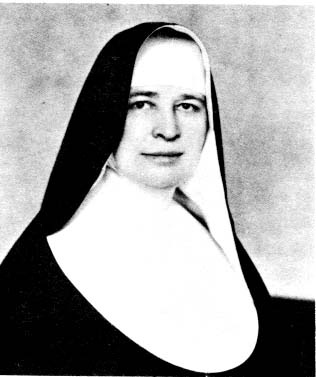Editor of this issue: Thomas Remeikis
Copyright © 1984 LITUANUS Foundation, Inc.

|
LITUANUS
LITHUANIAN QUARTERLY JOURNAL OF ARTS AND SCIENCES
Volume 30, No.2 - Summer 1984
Editor of this issue: Thomas Remeikis ISSN 0024-5089
Copyright © 1984 LITUANUS Foundation, Inc. |

|
Kazimiera Kaupaitė Motina Marija by Vincentas Brizgys
(Draugas, Chicago, 1982), 189 pages, hard cover, no price given.
Evidently Bishop Brizgys' long association with the Sisters of St. Casimir and his warm sentiments for them prompted him to pen this series of vignettes about their foundress. Using several hitherto untapped primary sources, the author offers a brief, popular introduction to Lithuanian readers about a remarkable pioneer religious, whose undistinguished peasant youth hardly forecast her extraordinary role away from her homeland in the New World. Once she was chosen as Superior General in 1913, she was repeatedly re-elected, with Vatican approval, until her death. Indeed, her obituary of 1940 in the Chicago Examiner called her a "second Cabrini," (p. 156). Marija Kaupaitė not only launched the first Lithuanian community of nuns in the United States in 1907, but later in 1920 expanded her apostolate to her land of birth. There her legacy was most impressive: twenty-nine primary schools, three secondary schools, and two hospitals. Little wonder that she received the "Gediminas" medal in 1933 from the Lithuanian government in recognition of her contribution to the state. (In fact, the government also awarded this insignia to Mother Cyril of the Scranton-based Immaculate Heart Sisters (p. 80) for her guidance and counsel during the infant stages of formation of the Casimirites.)
Nevertheless, only four decades after her death has Mother Maria begun to gain some attention in her own ethnic circles. Hitherto Lithuanian-language sources have had little to say about this sterling character. Kučas' history Amerikos Lietuvių Istorija, for instance, does not even have an index entry under "Kaupaitė," though he does give some mention to the Sisters themselves.
Some significant data, not generally known, comes to light in this slender volume. Here are some examples. The reader is enlightened to learn of early deaths among the Sisters (p. 123) nineteen in their youth prior to 1940, and many, still in their prime, who were handicapped by illness of one kind or another. What's more, there is the detail about the American Red Cross furnishing
bed linens and blankets to the Sisters (p. 130), as they established their mission in Pažaislis, Lithuania under post-war conditions of want. Furthermore, there is the unsuccessful caper of Archbishop Skvireckas and his partisans (p. 140-2), seeking to make a sudden break with the American Sisters, by inaugurating an independent community. Finally, one learns that Mother Marija and her Sisters are credited with reviving in 1938, at the request of Cardinal Mundelein, the bankrupt Loretto Hospital in Chicago.
On the disputed issue of the true founder of the Sisters of St. Casimir, Bishop Brizgys offers a revisionist view (p. 162-65). In his biography of Milukas, Mingėla lauds his subject as deserving the principal acclaim as founder. Kučas, in his biography of Staniukynas, stresses the latter's role as instigator. Indeed, the towering monument of Staniukynas, erected on the motherhouse grounds in the 1920s, bears the inscription "įsteigėjas" (founder). Some time later, the Sisters, in a revisionist mood, officially settled on the title "co-founder" for the priest. Bishop Brizgys puts both Milukas and Staniukynas aside, goes beyond the view of the Sisters themselves, and delcares Mother Maria as foundress, "about which there is no basis for doubt whatsoever," (p. 165).
Some intriguing questions about Mother Maria and the Sisters remain yet unsolved. Why did Bishop John Shanahan of the Harrisburg diocese (site of the first Casimirite mission at Mount Carmel, Pennsylvania) the original benefactor of the community momentarily lost heart over their future viability (p. 82)? And why did he quickly revert to his earlier optimism? And what was the precise role of Bishop Michael Hoban of the Scranton diocese, in whose jurisdiction the first Sisters trained? Lithuanian sources indicate that the Sisters soon shifted their attention to Chicago, as the recognized population center of Lithuanians, and established their motherhouse there, rather than in Pennsylvania. Yet Charles Shanabruch (p. 306, "The Catholic Church's Role in the Americanization of Chicago's Immigrants, 1833-1928," unpublished doc. diss.. Univ. of Chicago, 1975, and later published in a revised, abridged version) states that the Sisters came to Chicago at the bidding of Archbishop James Quigley to "ease tensions" between Lithuanians and Poles in the archdiocese. What tensions? Not an insignificant number of Lithuanian young women had joined Polish religious communities, in the absence of their own ethnic order of nuns. Nevertheless, Polish superiors often assigned Polish and not Lithuanian Sisters to teach in Lithuanian schools, while assigning

Mother Maria Kaupas (1880-1940), Foundress and First Superior General of the Sisters of Saint Casimir.
Lithuanian Sisters to non-Lithuanian settings. How many of such Lithuanian religious left Polish convents to affiliate with the Casimirites (and subsequent Lithuanian orders), and under what conditions did such "cross-overs" make their transition? Answers most likely lie hidden in diocesan archives yet to be inspected.
The story of the first and largest of religious congregations of Lithuanian origin in the United States goes beyond the bounds of ethnic history. The Sisters of St. Casimir rightly have a place in U.S. Catholic history as well. A thorough, analytic presentation cries out to be written. Using Bishop Brizgys' monograph, along with other available data, some candidate for a master's or doctoral degree would do well to consider this topic.
William Wolkovich-Walkavicius Hudson, Mass.